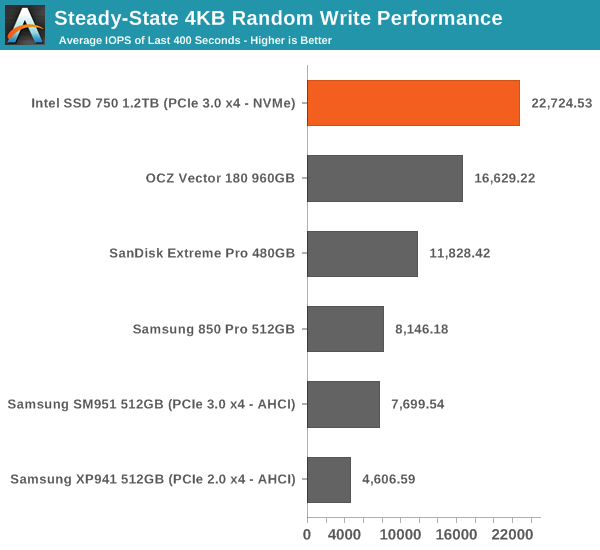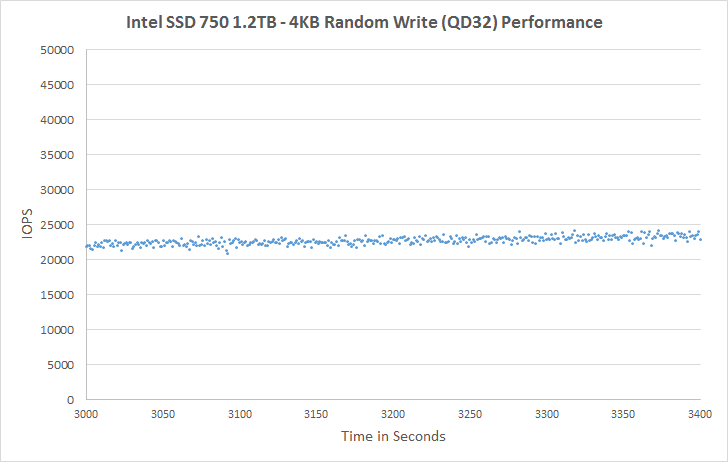Intel SSD 750 PCIe SSD Review: NVMe for the Client
by Kristian Vättö on April 2, 2015 12:00 PM ESTPerformance Consistency
We've been looking at performance consistency since the Intel SSD DC S3700 review in late 2012 and it has become one of the cornerstones of our SSD reviews. Back in the days many SSD vendors were only focusing on high peak performance, which unfortunately came at the cost of sustained performance. In other words, the drives would push high IOPS in certain synthetic scenarios to provide nice marketing numbers, but as soon as you pushed the drive for more than a few minutes you could easily run into hiccups caused by poor performance consistency.
Once we started exploring IO consistency, nearly all SSD manufacturers made a move to improve consistency and for the 2015 suite, I haven't made any significant changes to the methodology we use to test IO consistency. The biggest change is the move from VDBench to Iometer 1.1.0 as the benchmarking software and I've also extended the test from 2000 seconds to a full hour to ensure that all drives hit steady-state during the test.
For better readability, I now provide bar graphs with the first one being an average IOPS of the last 400 seconds and the second graph displaying the standard deviation during the same period. Average IOPS provides a quick look into overall performance, but it can easily hide bad consistency, so looking at standard deviation is necessary for a complete look into consistency.
I'm still providing the same scatter graphs too, of course. However, I decided to dump the logarithmic graphs and go linear-only since logarithmic graphs aren't as accurate and can be hard to interpret for those who aren't familiar with them. I provide two graphs: one that includes the whole duration of the test and another that focuses on the last 400 seconds of the test to get a better scope into steady-state performance.

Given the higher over-provisioning and an enterprise-oriented controller, it's no surprise that the SSD 750 has excellent steady-state random write performance.

The consistency is also very good, although the SSD 750 can't beat the 850 Pro if just focusing on consistency. When considering that the SSD 750 provides nearly three times the performance, it's clear that the SSD 750 is better out of the two.
 |
|||||||||
| Default | |||||||||
At the initial cliff the performance drops to around 15K IOPS, but it quickly rises and seems to even out at about 22-23K IOPS. It actually takes nearly an hour for the SSD 750 to reach steady-state, which isn't uncommon for such a large drive but it's still notable.
I couldn't run tests with added over-provisioning because NVMe drives don't support the usual ATA commands that I use to limit the LBA of the drive. There is similar command set for NVMe as well, but I'm still trying to figure out how to use them as there's isn't too much public info about NVMe tools.
 |
|||||||||
| Default | |||||||||










132 Comments
View All Comments
Kristian Vättö - Thursday, April 2, 2015 - link
That's up to the motherboard manufacturers. If they provide BIOS with NVMe support then yes, but I wouldn't get my hopes up as the motherboard OEMs don't usually do updates for old boards.vailr - Thursday, April 2, 2015 - link
If Z97 board bioses from Asus, Gigabyte, etc. are going to be upgradeable to support Broadwell for all desktop (socket 1150) motherboards, wouldn't they also want to include NVMe support? I'm assuming such support is at least within the realm of possibility, for both Z87 and Z97 boards.TheRealPD - Thursday, April 2, 2015 - link
Has anyone worked out exactly what the limitation is/why the bios needs upgrading yet?Simply that I had the idea that the P3700 had it's own nvme orom, nominally akin to a raid card... ...& that people have had issues with the updated mobo bioses replacing intel's one with a generic one...
...which kind of suggests that the bios update could conceivably not be a requirement for some nvme drives.
vailr - Friday, April 3, 2015 - link
A motherboard bios update would be required to provide bootability. Without that update, an NVMe drive could only function as a secondary storage drive. As stated elsewhere, each device model needs specific support added to the motherboard bios. Samsung's SM941 (an M.2 SSD form factor device) is a prime example of this conundrum, and why it's not generally available as a retail device. Although it can be found for sale at Newegg or on eBay.TheRealPD - Friday, April 3, 2015 - link
Ummmm... Well, for example, looking at http://www.thessdreview.com/Forums/ssd-discussion/... then the P3700 could be used as a boot drive on a Z87 board in July 2014 - so clearly that wasn't using a mobo bios with an added nvme orom as ami hadn't even released their generic nvme orom that's being added to the Z97 boards.(& from recollection, on Z97 boards, in Windows the P3700 is detected as an intel nvme device without the bios update... ...& an ami nvme one with the update)
This appears to effectively the same as, say, an lsi sas raid card loading it's own orom during the boot process & the drives on it becoming bootable - as obviously, as new raid cards with new feature sets are introduced, you don't have to have updates for every mobo bios.
Now, whilst I can clearly appreciate that *if* a nvme drive didn't have it's own orom then there would be issues, it really doesn't seem to be the case with drives that do... ...so is there some other issue with the nvme feature set or...?
Now, obviously this review is about another intel nvme pcie ssd - so it might be reasonable to imagine that it could well also have it's own orom - but, more generally, I'm questioning the assumption that just because it's an nvme drive you can *only* fully utilise it with a board with an updated bios...
...& that if it's the case that some nvme ssds will & some won't have their own orom (& it doesn't affect the feature set), it would be a handy thing to see talked about in the reviews as it means that people with older machines are neither put off buying nor buy an inappropriate ssd when more consumer orientated ones are released.
TheRealPD - Saturday, April 4, 2015 - link
I think I've kind of found the answer via a few different sources - it's not that nvme drives necessarily won't work properly with booting & whatnot on older boards... it's that there's no stated consistency as to what will & won't work...So apparently they can simply not work on some boards d.t. a bios conflict & there can separately be address space issues... So the ami nvme orom & uefi bios updates are about compatibility - *not* that an nvme ssd with its own orom will or won't necessarily work without them on any particular setup.
it would be very useful if there was some extra info about this though...
- well, it's conceivable that at least part of the problem is akin to the issues on much older boards with the free bios capacity for oroms & multiple raid configurations... ...where if you attempted to both enable all of the onboard controllers for raid (as this alters the bios behaviour to load them) &/or had too many additional controllers then one or more of them simply wouldn't operate d.t. the bios limitation; whereas they'd all work both individually & with smaller no's enabled/installed... ...so people with older machines who haven't seen this issue previously simply because they've never used cards with their own oroms or the ssd is the extra thing where they're hitting the limit, are now seeing what some of us experienced years ago.
- or, similarly, that there's a min uefi version that's needed - I know that intel's recommending 2.3.1 or later for compatibility but clearly they were working on some boards prior to that...
pesho00 - Thursday, April 2, 2015 - link
Why they omit M2? I really think this is a mistake missing the whole mobile market while SM951 will penetrate both!Kristian Vättö - Thursday, April 2, 2015 - link
Because M.2 would melt with that beast of a controller.metayoshi - Thursday, April 2, 2015 - link
The Idle power spec of this drive is 4W, while the SM951 is at 50 mW with an L1.2 power consumption at 2mW. Your notebook's battery life will suffer greatly with a drive this power hungry.jwilliams4200 - Thursday, April 2, 2015 - link
Even though you could not run the performance tests with additional overprovisioning on the 750, you should still show the comparison SSDs with additional overprovisioning.The fair comparison is NOT with the Intel 750 no OP versus other SSDs with no OP. The comparison you should be showing is similar capacity vs. similar capacity. So, for example, a 512GB Samsung 850 Pro with OP to leave it with 400GB usable, versus and Intel 750 with 400GB usable.
I also think it would be good testing policy to test ALL SSDs twice, once with no OP, and once with 50% overprovisioning, running them through all the tests with 0% and 50% OP. The point is not that 50% OP is typical, but rather that it will reveal the best and worst case performance that the SSD is capable of. The reason I say 50% rather than 20% or 25% is that the optimal OP varies from SSD to SSD, especially among models that already come with significant OP. So, to be sure that you OP enough that you reach optimal performance, and to provide historical comparison tests, it is best just to arbitrarily choose 50% OP since that should be more than enough to achieve optimal sustained performance on any SSD.